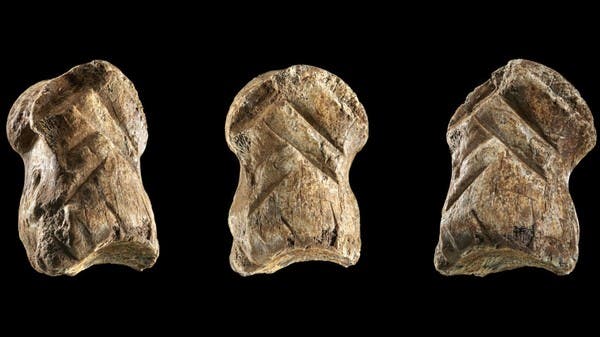Inside a cave in the Harz Mountains of central Germany, paleontologists have come across a striking artifact. The 51,000-year-old toe bone belonging to a prehistoric deer was purposefully carved with lines by Neanderthals, quite possibly with a symbolic meaning. It may very well be the world’s oldest art, claim German researchers.
The front side of the bone is carved with overlapping chevrons (inverted Vs) that point upwards with smaller incisions on the lower edge that might have served as a base. When the artifact was placed on its base, it didn’t tip over. “It was probably left standing upright in a corner of the cave,” said archaeologist Dirk Leder of the Lower Saxony state office for Cultural Heritage.
Alongside the carved toe bone, archaeologists discovered the shoulder blade bones of deer, which may or not have belonged to the same animal, as well as the skull of a cave bear. These remains were, interestingly enough, discovered in Einhornhöhle, also known as ‘Unicorn Cave’, due to the fossilized bones found there since the 16th century which locals believed came from fabled unicorns.
Modern excavations at Unicorn Cave showed the site was inhabited by successive generations of Neanderthals from at least 130,000 years ago until 47,000 years ago when they went extinct. Only much later, starting about 12,000 years ago, did modern humans take over the cave.

The researchers are confident that the artifact was carved by Neanderthal hands rather than humans. Although humans and Neanderthals were acquainted by the time the bone was etched 51,000 years ago, our species had yet to make its presence known at Einhornhöhle. Neanderthals were the only hominids in that part of Europe (and Einhornhöhle specifically) at the time, the researchers claim in their study published in the journal Nature Ecology & Evolution.
Concerning the meaning of the chevron carvings, the archaeologists can only speculate. It may represent a female figurine, a mountain landscape, or some abstract art.
What seems more certain is that the bone was carved purposefully as an ornament rather than the result of butchery. The carvings are etched deep, which means the bone was likely boiled beforehand to make it softer. The deer species, Megaloceros giganteus, from which the bone came was quite rare in the region, which would have made the artwork all the more special.
This symbolistic artifact is not singular among Neanderthal culture. Previously, researchers uncovered a pendant made from ancient eagle talons and cave paintings in Spain made by Neanderthal artists. Together, these findings show that Neanderthals’ reputation as brutes is undeserved.
But this also raises an even more exciting possibility: since both humans and Neanderthals shared creative abilities, it’s possible that they both inherited them from a common ancestor. If this is the case, we might have to look even further — much further — down in history to find where these abilities first appeared. In the process, we may learn how humans came to develop the qualities we now endow to humanity.
Leder and colleagues plan on performing more digs at Einhornhöhle in the hope they might find other engraved artifacts, perhaps stashed away in some dark corner of the cave.



